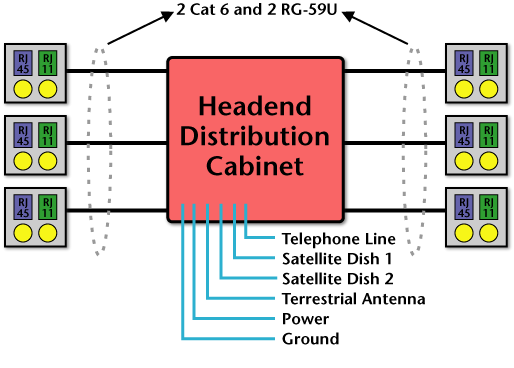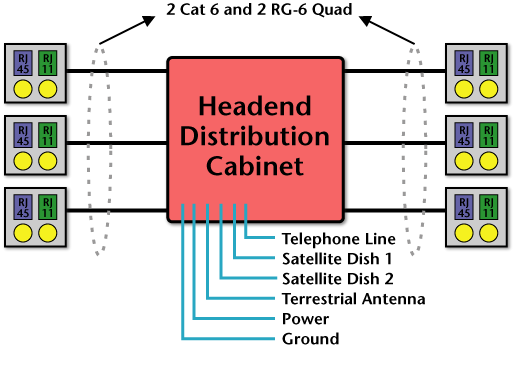Installing Structured Wiring
Some security dealers and integrators see structured cabling as a logical extension of their traditional security system work because it involves low-voltage cables. Although this is true, proper installation of data cables requires new skills and has many restrictions that do not apply to traditional security wiring. If you are considering venturing into this market, take the following quiz.1. What type of cable should be run for a voice telephone system?
a. Cat 3
b. Cat 5
c. RG-59U
d. RG-6 Quad
e. Any of the above
2. What type of cable should be run for a 100 MHz data network system?
a. Cat 3
b. Cat 5
c. RG-59U
d. RG-6 Quad
e. Any of the above
3. What type of cable should be run for a satellite TV system?
a. Cat 3
b. Cat 5
c. RG-59U
d. RG-6 Quad
e. Any of the above
4. What type of cable should be run for a digital cable TV system?
a. Cat 3
b. Cat 5
c. RG-59U
d. RG-6 Quad
e. Any of the above
5. Cat 5 cable is only available in a four-pair configuration.
a. True
b. False
6. Which of the following cable types can transmit signals over the longest distance?
a. UTP
b. COAX
c. Fiber
d. They all have the same maximum distance capability.
7. Which of the following can provide a source of emergency power in the event of a blackout?
a. Surge suppressors
b. Line filters
c. UPS
d. Power regulators
8. Which of the following features should be considered when selecting a surge suppressor?
a. Clamping voltage
b. Clamping speed
c. Joule rating
d. All of the above
9. Telephone lines do not require electrical protection.
a. True
b. False
10. What tests should be done to verify the capabilities of data network cables?
a. Opens/shorts
b. Cross pairs
c. Split pairs
d. All of the above
11. A standard VOM is the only tool necessary to properly test data network cabling.
a. True
b. False
12. In a token ring network, all cables are “home run.â€
a. True
b. False
13. All connections in a 100 MHz data network should be soldered and taped.
a. True
b. False
14. Cat 3 UTP cable can support data speeds up to:
a. 10 MHz.
b. 100 MHz.
c. 1 GHz.
100 GHz.

What’s Wrong with This?
Wally `Larman installed a structured wiring system for six rooms. He put the head end in a central closet and ran the cables shown in this diagram. While he was running the cables, he was careful not to overstretch or damage the wires, and he kept them away from all electrical wire and devices. He carefully connected the cables to the appropriate connectors, but when satellite company technicians arrived to install their equipment, a problem was discovered. Can you see what Wally did wrong and what he should do to correct his mistake?5-Minute Tech Quiz Answers
Here are the answers to What’s Wrong with This? and the 5-Minute Tech Quiz:1. a – Although a Cat 3 cable will suffice for most voice telephone systems, some manufacturers recommend running a Cat 5 or better to allow for future enhancements.
2. b
3. d – Some satellite systems require two RG-6 cables to accommodate dual-tuner DVRs. They also may require a telephone line at each satellite receiver.
4. d
5. b – Cat 5 cable is available in many different pair configurations.
6. c – Without using any in-line boosters, fiber-optic cable can transmit signals over a much longer distance that UTP or COAX cables.
7. c – Only an uninterruptible power supply (UPS) can provide emergency power during a blackout. The other devices can only reduce problems caused by electrical spikes or surges.
8. d – All these ratings are important. The clamping voltage is the threshold beyond which the suppressor begins its protection. Clamping speed is how quickly a device reacts to a change in voltage. The joule rating determines a device’s capacity to absorb electricity.
9. b- Power surges from lightning can travel up telephone or electrical power lines.
10. d
11. b – Although a traditional VOM can detect electrical opens, shorts and grounds, it is not designed to test cables over the range of transmission speeds that data networks require.
12. b
13. b – Splicing and “T†taping of network cables is not recommended. All terminations should be accomplished using connectors that have the same rating as the cable.

